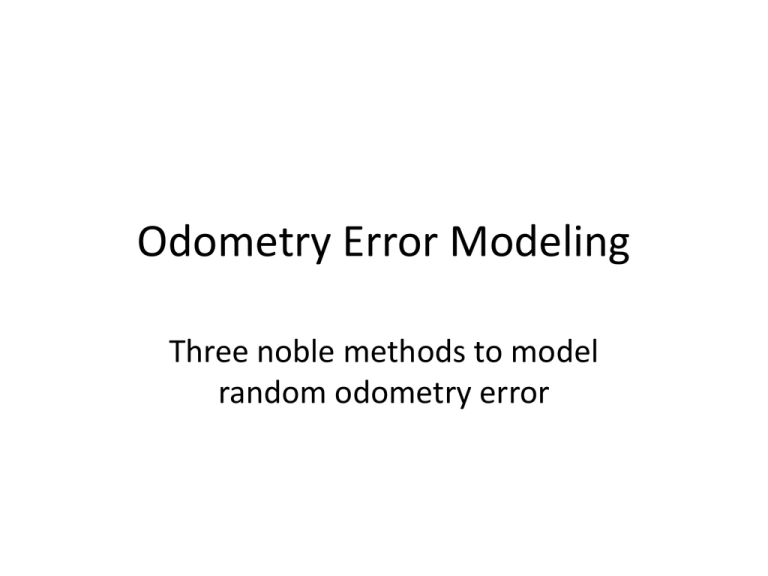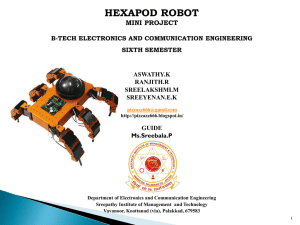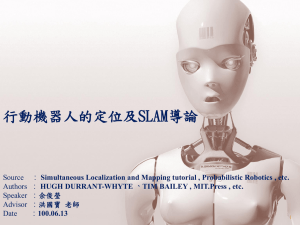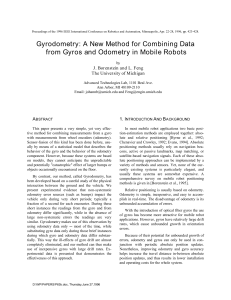Document
advertisement

Odometry Error Modeling Three noble methods to model random odometry error Two types of odometer errors • Systematic error – Can be avoided by calibrating the wheel encoder – Can accounted for in software • Random error – Difficult to calibrate or find a closed form formula – Mathematically modeled – Significant source of confidence level degradation Systematic error • UMBmark test – Let the robot follow a defined path several times – Compare the deviation of the robot in CW/CCW – Calculate the weighted Cartesian offsets – Correct error in software/hardware Example, UMBmark with square of side D Robot covers a square of side D, n times in both CW and CCW sense. At the end of each lap, the error in x and y direction are recorded. Random error modeling 1 • This model expresses the covariance matrix in terms of four parameters: ET ER Ktheta Krho • Here are the relations: – Vtheta = Ktheta * (Translation speed) – Vrho = Krho * (Translational speed) – Note: V stands for variance • The other two parameters describe systematic errors (thus uninteresting) How to determine parameters • Perform simple robot movements, such as moving back and fro for a certain number of times. • Measure several “observables”, quantities to be measured from the robot’s movement • Calculate the four parameters from the measured observables. • Certain observables give a better estimation of the parameters. The paper lists best observable to estimate each model parameter. Model 2 • Any robot path can be decomposed into three primitive movements: circular motion, turn on spot, straight motion. • This model finds closed form formula for error propagation for circular motion. • Using this model the robot updates its odometery covariance matrix only when the robot changes type of motion. So faster computation and independent of sequence of action Model 3 • This model takes into account the variation in the wheel diameter and wheel separation. • A model that incorporates the random wheel variation to covariance matrix was found. • Result shows final error propagation is just the sum of covariance propagation with no wheel variation and a new error factor. • The new error factor updates the wheelvariation-covariance matrix (Q) Result of model 3 Odometry Error Correction • Nonsystematic Error Correction – OmniMate Design – Sensor Fusion • Systematic Odometry Error Correction – Systematic Error Compensation Systematic and Nonsystematic Errors • Systematic errors: errors in design – – – – Unequal wheel diameters Misalignment of wheels Limited sampling resolution Uncertainty about effective wheelbase • Nonsystematic: errors due to environment -Travel over uneven floor -Unexpected object on the floor -Wheel slippage Nonsystematic Error Correction: OmniMate Design • Freedom mobile platform • omnidirectional capabilities • Two differential-drive TRC LabMate platforms • Front and rear can rotate around A and B OmniMate Design (continue) OmniMate (continue) • IPEC: Internal Position Error Correction (OmniMate control System) • Detect automatically and correct nonsystematic odometry errors Nonsystematic Error Correction: Sensor Fusion • Fusion of data from gyroscope and odometry systems for a long time travel – If dataG – dataE > prefix threshold, dataG is used to compute orientation angle. Otherwise use dataE – Threshold adapted to different environment – Kalman filters to reduce noise and measure angular position Systematic Error Correction • Substantial odometry error: effect on straight line motion – Ed=DR/DL • Wheelbase error: effect when turning Eb=bactual/bnominal: expressed as a function of the nominal value Systematic Odometry Errors Compensation • R=(L/2)/sin(beta/2) • Eb=(R+b/2)/(R-b/2)= DR/DL • Da=(DR+DL)/2 • DL=2Da/(Ed+1) • DR=2Da/((1/Ed)+1) • Correction Factors: – Cl=2/(Ed+1) – Cr=2/((1/Ed)+1) Simultaneous Location and Mapping (SLAM) Purpose • Replace the need to manually create and update maps – Map becomes invalid if an object begins moving or the map is rearranged – Allows for the robot to be truly autonomous Primary Goal • Be able to start from an arbitrary point • autonomously explore the local environment using its on-board sensors, • analyze the location and map the area • determine its actual location on the self constructed map Popular Implementations • Visual-SLAM algorithm on the extended Kalman filter • Graph-SLAM algorithm • Particle-filter slam Visual-SLAM algorithm on the extended Kalman filter • Combines the extended Kalman filter results with robot pose and feature locations • Data is updated each iteration which leads to high computation costs with a lot of features • Implementations have been progressive to allow for maps to be broken down to more manageable datasets Graph-based SLAM • Constraints between robot and feature are seen as “soft” constraints • Creates a grid map of the robot location and features • Capable of solving the SLAM problem by calculating the area of least required engergy on the grid Particle filter Slam • Represents the object location certainty in samples instead of Gaussian probability • Good for nonlinear transformations and any type of non-Gaussian distribution Handling Errors • Any error in one iteration will continue to grow as more iterations are done • Common approach for correcting this error is to return to a feature who’s location and characteristics are well know • This minimizes uncertainty across the rest of the map as well Room for Improvement • Dynamic object pose a large problem for SLAM – Robot is quickly working within an invalid map – Attempt at a solution is to treat a dynamic object differently from a static feature on the map (outlier) – Any successful attempt at determining moving objects and their destination would drastically improve the SLAM process Room for Improvement • SLAM is very sensitive to errors • This error is especially detrimental when the robot attempts to minimize uncertainty by returning to a know object • Commonly used laser rangefinders are prone to missing some of the feature’s details – The use of an on board camera is useful for features – SIFT Function Q&A








